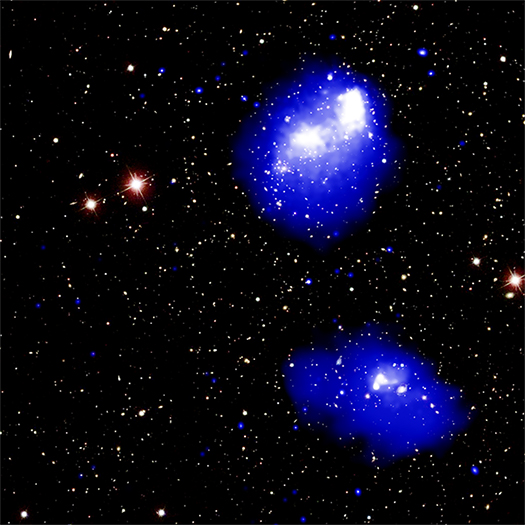Witnessing the Formation of One of the Most Massive Objects in the Universe

Gerrit Schellenberger
We welcome Gerrit Schellenberger as our guest blogger. He received his PhD in Bonn, Germany in 2016, and has been a post-doctoral researcher at the Center for Astrophysics | Harvard & Smithsonian since March 2016. His research includes working on galaxy clusters and groups in large samples for cosmology, but also on individual objects in the X-rays and in the radio regime.
From the beginning of my astronomical career, I was fascinated by studying galaxy clusters, consisting of hundreds, sometimes even thousands of galaxies held together by gravity only. Yet, the galaxies alone do not — by far — sum up to the mass necessary to keep the cluster bound together. Beginning in the 1970s after the birth of X-ray astronomy and the first imaging satellites such as Einstein and ROSAT, scientists discovered that a very hot gas exists between the galaxies of the cluster. The mass of this gas exceeds the mass of all the stars in the galaxies together.
Although this gas is the most dominant, visible structure in galaxy clusters, it is only about 10% of the total mass (while the stars in the galaxies make only about 1%). The rest, roughly 90%, is dark matter, which cannot be observed directly. However, we can see its effect on the hot gas and galaxies in galaxy clusters: the gravity not only keeps the galaxies within the cluster, but also compresses the gas, heating it to the point where it emits X-rays. So we can study dark matter in clusters by measuring the properties (like temperature) of the hot gas from the X-ray emission.
Intrigued by this, I started to analyze a sample comprising 64 clusters during my PhD in Bonn, Germany, with the goal of obtaining total masses (including the dark matter component) for all of them. It turns out that smaller and lighter galaxy clusters, also called galaxy groups, do not follow the expected scaling between X-ray emission and temperature at a given cluster mass, meaning that the X-ray properties of gas in these systems cannot be used to give reliable mass estimates. Therefore, galaxy groups can only be of limited use for cosmological studies, where it is crucial to estimate the amount of matter in objects and how it changes with cosmic time.
On the other hand, the most massive objects, although they are very rare, are the ones that best trace the evolution of the structure that we observe in the past and in the present-day Universe. The total amount of all matter in the Universe, the density of tiny clumps existing in material after the Big Bang (from which structures formed), and the expansion rate of the Universe all determine the number of massive clusters we can observe today.
The most massive clusters are not only very useful for cosmology, but also help us understand the processes by which clusters form. Simulations tell us that galaxy clusters form along cosmic filaments, which are enhanced density structures that permeate the Universe like a spider's web. Massive clusters should then form at the intersections of big filaments. But astronomers are still looking for conclusive observational evidence that massive cluster mergers occur at these intersections.
Abell 1758 is a galaxy cluster system that was originally discovered as one single cluster, but follow-up observations showed it to consist of two separate clusters: one northern and one southern, separated by about 6 million light years. Both of these clusters show indications that they are themselves still forming through their own strong mergers between two smaller galaxy clusters. More recently, the violent merger in the northern cluster has been confirmed, and the southern cluster seems to be in an earlier stage of merger. Eventually, the northern and southern clusters will also collide, so the whole system is a quadruple merger, which makes this a uniquely interesting case to study.
This triggered us to propose for very deep, high-resolution X-ray data from Chandra and combine it with a very large catalog of optical data of the individual galaxies. We also added radio data with relatively low frequencies (corresponding to relatively long radio wavelengths) to trace non-thermal emission. Such emission involves radiation that is not related to the temperature of an object, such as by the acceleration of charged particles such as electrons in magnetic fields. It is produced in merging systems, since the energies involved can accelerate charged particles to relativistic velocities, that is, a significant fraction of the speed of light.
With the available data we wanted to answer some fundamental questions about this system: A major merger as in the northern cluster of Abell 1758 should leave strong imprints in the hot gas, especially shock fronts, which are similar to the sonic booms produced by supersonic aircraft. Moreover, we expect to see a population of relativistic particles with radio observations. Can the observations confirm these predictions? Are the two pairs of clusters - Abell 1758 North and South - already beginning to merge? A cluster combining Abell 1758 North and South, will likely be the most massive bound structure in the Universe. Can the relative motion of the individual galaxies tell us if there are enormous filaments, along which the clusters are aligned?
Using the very deep Chandra X-ray data and a novel approach to detect edges around the brighter regions in the hot gas, my collaborators and I were able to find the shock front associated with the merger in Abell 1758 North, and construct a more complete picture of that merger. The shock strength indicates clusters are moving toward compared to one another at a velocity 60% larger than the sound speed in the gas (supersonic). The position of the shock wave also matches well with a trailing cold front, which marks a sharp transition to a denser and cooler region of the gas. Also the diffuse radio emission found at a low frequency of 610 MHz with the Giant Metrewave Radio Telescope in India matches well the general picture of cluster merger.
However, given the mass of the individual constituents, we expected a shock front of even greater strength, as well as clear radio emission produced by charged particles accelerated by the shock front. The fact that we do not see this, and also have no clear indications of a shock front on the other side (which is in theory expected), suggests that the merger energy may not be transferred into the gas as effectively as we might assume. Another possibility is that more time is needed for the structures created by the merger to develop and become more visible.
We can see in the southern cluster, where we find even less merger indications (no strong shock front, only weak radio emission), that the two sub-clusters are just in core-passage stage, which means they have reached the smallest separation and will then begin to move away from each other. We find several edges around the merger in the southern cluster, but none of them can clearly be identified with a shock front.
Our optical dataset combines observations of several telescopes, among them the 6.5-meter diameter MMT telescope in Arizona, and the Gemini North telescope in Hawaii. We can characterize not only the galaxy positions, but also their relative velocities toward us. We used this three-dimensional information to determine whether each galaxy belongs to the northern or southern cluster. We were also able to identify galaxies belonging to several small groups that are falling into one of the larger clusters. This shows that there might be a large filament present along which smaller groups of galaxies form and fall onto the massive clusters. However, from the locations of these groups, the filament is almost perpendicular to the anticipated merger axis of the two large clusters, which is unexpected.
Our research was made possible mainly by the high-resolution X-ray images of Chandra. We were able to answer some open questions about this interesting system, but some issues are still not solved. The best approach for the future is to find and study more similar systems, which are likely at larger distances from us requiring longer observing times. Detailed future X-ray surveys, like eROSITA, will help us to detect more systems like Abell 1758.
Please note this is a moderated blog. No pornography, spam, profanity or discriminatory remarks are allowed. No personal attacks are allowed. Users should stay on topic to keep it relevant for the readers.
Read the privacy statement

